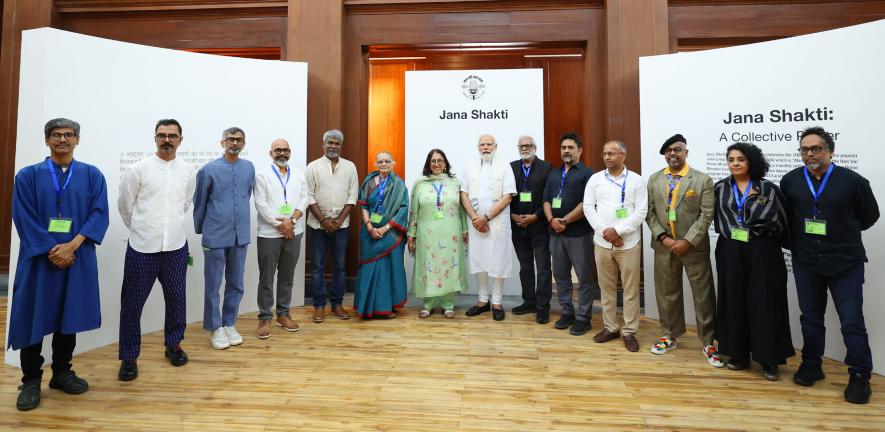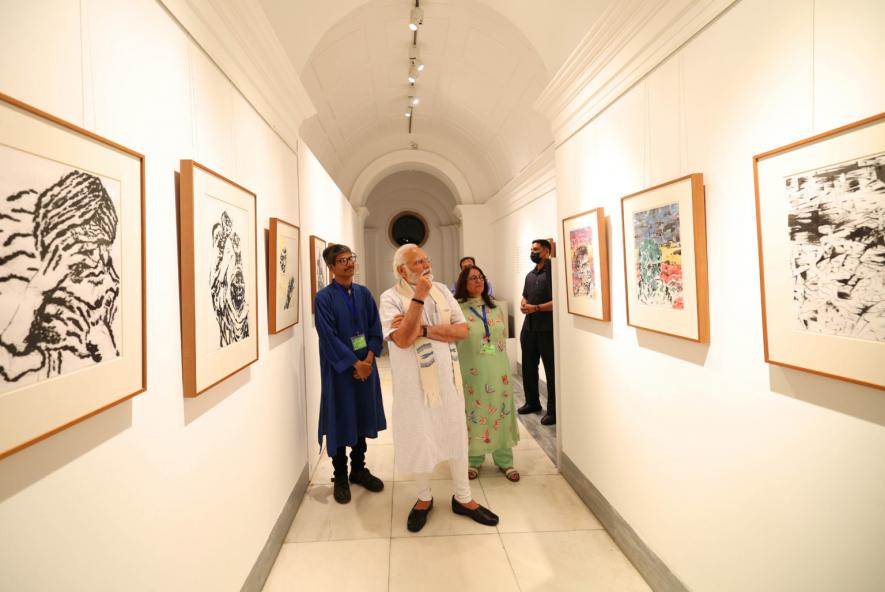Now, Godi Artists?

Image courtesy Govt of India Press Release
The Indian art world has been in ferment the last few weeks over the show Jana Shakti: A Collective Power which opened at the National Gallery of Modern Art, NGMA, Delhi, on 30th April ‘as an immersive experience‘ to celebrate the hundredth episode of Prime Minister Modi’s radio programme Mann ki Baat. The artists were named and shamed in a scathing piece on the show by art historian Santhosh Sadanand in his Facebook post titled Radio Unity – Radio Silence, which set the show squarely in the context of Nazi history and its use of the radio for fascist propaganda. Twelve artists: Atul Dodiya, Manu and Madhvi Parekh, Riyas Komu, G. R. Iranna, Ashim Purkayastha, the team of Thukral and Tagra, Pratul Dash, Jagannath Panda, Vibha Galhotra, Paresh Maity and Manjunath Kamath, all had works responding to a Mann ki Baat episode, endorsing a particular BJP government programme. There was a lunch with PM Modi for which the artists got calls from the Ministry of Culture. A widely circulated video has him meeting and talking to each artist at the inauguration, ending with a group photo. Some of the artists have outed themselves as Bhakts. There is an eerie familiarity to this. Didn’t this happen some time ago in the Hindi film industry? First, a group of prominent film people was invited to meet the PM, and a group photo was taken. Slowly, some of them became BJP ambassadors. Some of them started making films on government programmes. One of them did a famous ‘mango’ interview. And so on.
In 2012, when some of us had given a call for boycotting the first major Indian show to celebrate Israel-India ties to mark the opening of the new wing of the Tel Aviv Museum in support of the international cultural boycott of Israel, there was much discussion about it in the art world. Most of the invited artists decided to participate. The boycott call got a lot of coverage in the Indian press, the Israeli and Palestinian TV and press, and otherwise internationally, resulting in the exhibition finally becoming very low–key. The curators changed the controversial title and curatorial premise, which had compared India and Israel’s history as being the same: that of a forced partition (which ‘similarity’ is, in fact, completely wrong historically). The artists’ arguments for their participation were to say that every show was problematic — or that they would show works that would subvert the premise of the show.
If artists think that their works in this exhibition will somehow subvert the ideology of the Sangh and its agenda of ethnic cleansing, its contempt for the poor and the marginal, its worship of the rich, and its utter misogyny, they should have only looked a few blocks away at our young award–winning women wrestlers, all from the rural heartlands, who had been sitting in protest at Jantar Mantar in a real show of People’s Power, against sexual harassment by a powerful BJP MP and local don. They did not succumb to pressure. The Prime Minister, immersed in his own Mann ki Baat — his one–sided soliloquies — did not even talk to them. While the PM was inaugurating the new Parliament building, the police manhandled and arrested the wrestlers who were going there to protest. Our artists, meanwhile, have got appropriated and subverted by the Sangh and become Godi – lapdog – artists.
The situation went from the sublime to the ridiculous, with the prolific critic Uma Nair standing in front of one of the artists’ paintings of flowers, singing Pete Seeger’s anti-Vietnam protest song ‘Where Have all the Flowers Gone’ to promote the show!
The art world in India is a close-knit community, with artists helping and hosting each other. Several artists are friends, and seeing their names here was a nasty shock. Were these artists so naïve, or were they just opportunistic or sycophantic in supporting the propaganda show of a fascist government? Can artists afford to be politically naïve? Were they afraid of government agencies coming after them? Is it the art market? If the excuse is pressure, surely the test of one’s beliefs and principles is to withstand pressure, not to buckle under it? Especially since several ‘A-list’ artists did indeed refuse when approached to participate, which means that refusal was possible.

Image courtesy Govt of India Press Release
I do not think the works were made especially for the show and to celebrate Mann ki Baat episodes as made out. The exhibition was organised in a short time and they are all existing works fitted into the themes by the curator Alka Pande, with Kiran Nadar as the advisor. In the wall texts, the original notes given by the artists have been altered to say that a Mann ki Baat episode has inspired the artwork. This is besides quotations from the radio programme scattered all over the exhibition. So what will be the outcome of this? The show is travelling to other NGMAs in India. The artists, many of whom have been working on Gandhi, Ambedkar, Buddha, environment, farmers‘ rights, women’s empowerment, justice, peace, harmony and so on, will lose credibility, as these are exactly what this government has been working against. But they may get lucrative government patronage and commissions. There is already a rumour that one of the artists has got an 18 crore art commission. The Triennale, the Lalit Kala Akademi, the NGMA, National Museum are all ripe fruits for plucking. They will become Godi artists who will be asked to make sycophantic propaganda like some of our Godi film stars.
I am not even going into discussing the roles of the curator and the ‘observer’ who belong to the art industry and will do what they will. In a strong article, Sandip K Luis — who incidentally works as a researcher in the KNMA — warns of an oligarchy forming in the Indian art world where centralisation of power is taking place, which is at once cultural, political and economic.
Most artists come from humble backgrounds, small towns and villages, and have not had an English education, contrary to the glamorous image painted in the media. It is a struggle to make art and keep making art. Many promising artists fade away those years after art school when they have to make a living and keep their faith in a difficult world where art is completely marginalised and seen as useless, decorative or a status symbol. Contemporary art theory itself looks at the spectator as a ‘consumer’ and art as a ‘product’. But every serious artist, I believe, chooses to be an artist as an act of idealism, as a philosophical enquiry.
This is a historical show because this is the first time that the RSS has tried to co-opt contemporary art. Modern and contemporary art is too free, too secular, too anarchic. The Sangh has always been hostile and suspicious about it. But it has extensively used popular art forms for its propaganda, like comics, children’s books, calendar paintings and religious TV serials. Interestingly, as part of the extravaganza to celebrate nine years of the Modi Government, the Culture Ministry has simultaneously released a twelve–part comic book series by Amar Chitra Katha on the episodes of Mann ki Baat in twelve languages, thereby seamlessly uniting the popular with the newly entered contemporary art world as agents of propaganda.
When the Sangh started rising some decades ago, the Bajrang Dal was unleashed on M. F. Husain, the most high–profile, successful and influential Indian artist — a Muslim. He was hounded for years with attacks on his shows and his home and with innumerable court cases when he was in his eighties till he left the country and finally died in exile. The attacks were always front-page news. Husain himself had faced criticism for his paintings celebrating Indira Gandhi as Durga during the Emergency.
We must not forget the continuous onslaughts on the Faculty of Fine Arts, Baroda, one of the premier art schools in this country. Known for the generations of important artists it has produced, some of whom are Padma awardees, and its liberal traditions and wide influence, it has been under constant siege since 2002. It suffers from intense scrutiny, spying, surveillance and even physical attacks. Gangs of VHP members with trishuls enter the campus on frequent checks, threaten the students, disturb the classes and create unnecessary controversies. As a student remarked, they are 400 students and staff against 40,000 in the University controlled by the ABVP. The object of the Sangh is to destroy this bastion of liberal thought in Gujarat. The School of Arts and Aesthetics at JNU, Delhi, is a more recent target as well, with most of its teachers charge-sheeted.
The RSS has long been mocked as lacking intellectual and cultural heft. But secretly, they always take criticism seriously and work inch by inch to get credibility. The Home Minister nowadays goes a week before electioneering begins in a state and has a meeting with ‘intellectuals’. The irony is that today, in whatever perverse way, only the Sangh is interested in culture and recognises the power of cultural expressions, while society generally has turned philistine. The artists in the show are seen as ‘influencers’. The RSS has recently entered the Hindi film industry, the most popular form in India today, with a huge international fan base. They want to destroy the Muslim Khans, who are the biggest stars and influencers and replace them with Hindu heroes. They are also busily making films on their favourite subjects like Savarkar, Modi, Kashmir, Love Jihad etc., leading up to the 2024 general elections. The Sangh wants to get all the forces of this country together to forge a ‘Radio Unity‘ to create the Hindu Rashtra.
To go back into some history, Dev Anand, during the Emergency, famously refused to say a few words of appreciation about Sanjay Gandhi when asked, which he described as a ‘call of conscience’. As a result, All India Radio and Television banned him and his films. The Anand brothers – Chetan, Vijay and Dev – and many of the actors, directors, scriptwriters and lyricists in Hindi cinema at the time had come from a background of the Indian People’s Theatre Association (IPTA) and the Indian Progressive Writers Association and were strongly influenced by leftist ideas. Most of the iconic films and immortal film songs that we hum today were written and composed by them. At the same time, there were the Progressive Artists Groups that came up all over India, the Bombay and Calcutta Progressives being the most well–known. The Sangh’s interest in destroying this strong socialist, progressive, secular, modern legacy and taking them over becomes quite obvious.
The Ministry of Culture’s Instagram videos show bites of the Jana Shakti exhibition running parallel to the videos of the new Parliament building. The new Parliament is shown as a culmination of thousands of years of Indian, read Hindu culture. Not even the Taj Mahal can be seen. The art history of India may be rewritten like the art history of Pakistan- which looks at Pakistan’s art history as an unbroken chain of Islamic art from the Mughal times.
Disclaimer: The views expressed in this article are the writer's own, and do not necessarily represent views of NewsClick.
Get the latest reports & analysis with people's perspective on Protests, movements & deep analytical videos, discussions of the current affairs in your Telegram app. Subscribe to NewsClick's Telegram channel & get Real-Time updates on stories, as they get published on our website.























